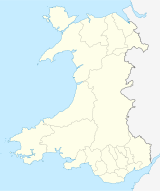Striguil Castle
| Chepstow Castle | |
|---|---|
| Chepstow, Monmouthshire, Wales | |

Chepstow Castle, with Marten's Tower to the left and the current gatehouse on the right
|
|
| Coordinates | 51°38′38″N 2°40′32″W / 51.643964°N 2.675417°WCoordinates: 51°38′38″N 2°40′32″W / 51.643964°N 2.675417°W |
| Type | Castle |
| Site information | |
| Owner | Cadw |
| Open to the public |
Yes |
| Condition | Mostly Intact |
| Site history | |
| Built | 1067–1300 |
| Built by |
William fitzOsbern William Marshal and his sons Roger Bigod |
| In use | 1067–1685 |
| Materials | Various forms of limestone and sandstone |
Chepstow Castle (Welsh: Castell Cas-gwent) at Chepstow, Monmouthshire, Wales is the oldest surviving post-Roman stone fortification in Britain. Located above cliffs on the River Wye, construction began in 1067 under the instruction of the Norman Lord William fitzOsbern. Originally known as Striguil, it was the southernmost of a chain of castles built in the Welsh Marches, and with its attached lordship took the name of the adjoining market town in about the 14th century.
In the 12th century the castle was used in the conquest of Gwent, the first independent Welsh kingdom to be conquered by the Normans. It was subsequently held by two of the most powerful Anglo-Norman magnates of medieval England, William Marshal and Richard de Clare. However, by the 16th century its military importance had waned and parts of its structure were converted into domestic ranges. Although re-garrisoned during and after the English Civil War, by the 1700s it had fallen into decay. With the later growth of tourism, the castle became a popular visitor destination.
The ruins were Grade I listed on 6 December 1950.
Chepstow Castle is situated on a narrow ridge between the limestone river cliff and a valley, known locally as the Dell, on its landward side. Its full extent is best appreciated from the opposite bank of the River Wye. The castle has four baileys, added in turn through its history. Despite this, it is not a defensively strong castle, having neither a strong keep nor a concentric layout. The multiple baileys instead show its construction history, which is generally considered in four major phases. The first serious architectural study of Chepstow began in 1904 and the canonical description was long considered to be by Perks in 1955. Recent studies have revised the details of these phases, but still maintain the same broad structure.
...
Wikipedia

